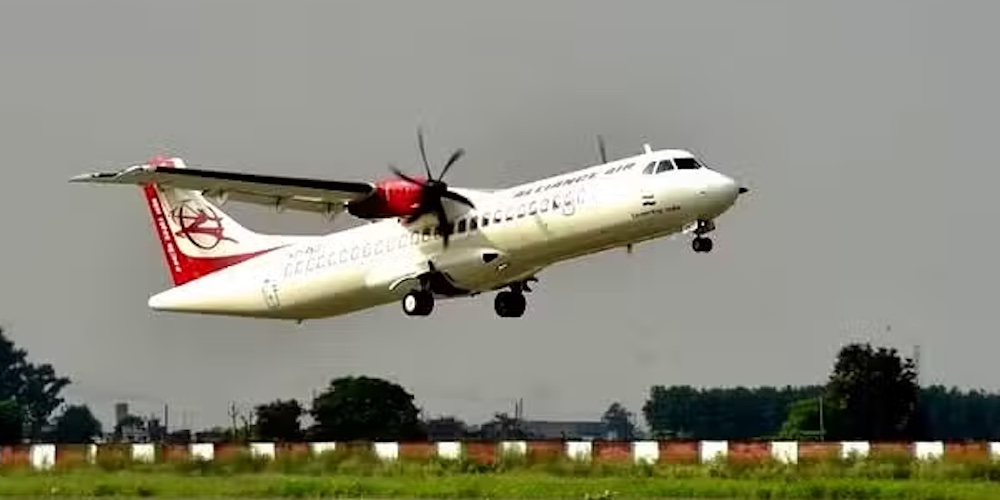Bridging the Sky

The Journey of UDAN has been a story of Inclusivity in Indian Aviation
In 2016, India had over 135 million air passengers, making it the tenth-largest civil aviation market at the time. While the sector was growing at a breakneck pace, there was an uneven development of airport infrastructure and air travel, which was concentrated in the metropolitan cities.
In order to bridge this gap and to leverage the growing demand for air travel, the UDAN-RCS was launched in 2016, as part of the broader National Policy on Civil Aviation (2016) by the Ministry of Civil Aviation. It aims for the dual objectives of increasing the growth of the aviation industry, and to make flying accessible to and affordable for the masses by reducing airfare costs, reviving and building airport infrastructure and by opening new air routes for travel.
The Dream Takes Flight
In a country where the sky often symbolizes hope and aspiration, the dream to fly is deeply rooted in the vision of Prime Minister Narendra Modi, who in a pivotal meeting before the National Civil Aviation Policy was announced, emphasised the need to democratize air travel. He famously remarked that he wanted to see people wearing slippers boarding planes, a sentiment that ignited the vision for a more inclusive aviation sector. This commitment to the common man’s dreams led to the birth of UDAN.
The first UDAN flight took off on April 27, 2017, connecting the serene hills of Shimla to the bustling metropolis of Delhi. This inaugural flight marked the beginning of a transformative journey in Indian aviation, one that would open up the skies to countless citizens.
The salient features of the scheme are as follows –
1. The Regional Connectivity Scheme – UDAN is designed to enable air operations on underserved / unserved routes connecting regional areas, promote balanced regional growth and make flying affordable for masses.
2. Financial incentives in terms of concessions / subsidies from the Central, State Governments and airport operators are extended to selected airline operators to encourage operations from unserved / underserved airports / heliports/water aerodromes and to keep the air fare affordable. Fares are to be capped at Rs. 2500 for one hour flights.
3. Financial Support to the Selected Airline Operators is in the form of Viability Gap Funding (VGF). State Governments provide 20% share towards VGF for RCS flights pertaining to their states. However, the share of VGF for North-Eastern states and the Union Territories is 10%.
4. Excise Duty at the rate of 1% / 2% is levied on Aviation Turbine Fuel (ATF) drawn by Selected Airline Operators at RCS Airports for RCS Flights for a period of three (3) years from the date of commencement.
5. Airlines are required to commit a certain number of seats as RCS seats, depending on the type and size of aircraft on RCS flights.
6. Regional Connectivity Fund (RCF) is created by a levy on each departure of flights on aircraft having a MTOW (Maximum Take-Off Weight) above 40 Tonnes. The RCF is created by a levy on the departure of flights on routes in the North-East Region, Himachal Pradesh, Uttarakhand, Union Territories of Jammu & Kashmir, Ladakh, Andaman & Nicobar Islands and Lakshadweep Islands.
7. For balanced regional growth, route allocations are spread equitably across five regions in the country, viz. North, South, East, West, and North East (with a cap of 30% in a given region).
8. RCS-UDAN is a market driven scheme. Interested airlines based on their assessment of demand on particular routes can submit proposals at the time of bidding under RCS – UDAN.
9. Tenure of the Scheme: The scheme to be applicable for a period of 10 years, subjected to periodic review and VGF support for the RCS route is available for a period of three years only.
Support Mechanisms
The government has implemented several supportive measures to attract airlines to operate flights in less lucrative markets:
• Airport Operators: They waive landing and parking charges for RCS flights, and the Airports Authority of India (AAI) does not levy Terminal Navigation Landing Charges (TNLC) on these flights. Moreover, a discounted Route Navigation and Facilitation Charge (RNFC) is applied.
• Central Government: For the first three years, excise duty on Aviation Turbine Fuel (ATF) purchased at RCS airports capped at 2%. Airlines are also encouraged to enter code-sharing agreements to expand their reach.
• State Governments: States have committed to reducing VAT on ATF to 1% or less for ten years and providing essential services such as security, fire services, and utility services at reduced rates.
This collaborative framework has fostered an environment where airlines can thrive while serving regions that have long been overlooked.
Fuelling Growth of the Aviation Industry
The RCS-UDAN scheme has played a pivotal role in revitalising the civil aviation industry in India. Over the past seven years, it has catalysed the emergence of many new and successful airlines. Regional carriers such as Flybig, Star Air, IndiaOne Air, and Fly91 have benefited from the scheme, developing sustainable business models and contributing to a burgeoning ecosystem for regional air travel.
The incremental expansion of the scheme has also generated a rising demand for new aircraft of all sizes, broadening the spectrum of planes deployed on RCS routes. This includes a diverse fleet, featuring the Airbus 320/321, Boeing 737, ATR 42 and 72, DHC Q400, Twin Otter, Embraer 145 and 175, Tecnam P2006T, Cessna 208B Grand Caravan EX, Dornier 228, Airbus H130, and Bell 407. Notably, Indian carriers have placed orders for over 1,000 aircraft slated for delivery in the next 10-15 years, significantly augmenting the existing fleet of approximately 800 planes.

Promoting Tourism
RCS-UDAN is not solely dedicated to offering last-mile connectivity to tier-2 and tier-3 cities; it also stands as a prominent contributor to the burgeoning tourism sector. Initiatives like UDAN 3.0 have introduced tourism routes connecting several destinations in the Northeast region, while UDAN 5.1 is focused on expanding helicopter services in hilly areas to stimulate tourism, hospitality, and local economic growth.
Significant destinations like Khajuraho, Deoghar, Amritsar, and Kishangarh (Ajmer) are now more accessible, catering to the religious tourism segment. Furthermore, the introduction of airports in Pasighat, Ziro, Hollongi, and Tezu has spurred growth in the Northeast’s tourism industry. Notably, Agatti Island has also been included in the Indian aviation map, enhancing tourism in Lakshadweep.
Boosting Air Connectivity
From Mundra in Gujarat to Tezu in Arunachal Pradesh, and Kullu in Himachal Pradesh to Salem in Tamil Nadu, RCS-UDAN has connected 34 states and Union Territories across the country. A total of 86 aerodromes have been operationalized under UDAN, including ten in the Northeast region and two heliports. Airports like Darbhanga, Prayagraj, Hubli, Belgaum, and Kannur are becoming increasingly sustainable, with many non-RCS commercial flights operating from these locations.
Soaring High: Some UDAN Airports
Darbhanga Airport (Civil Enclave): Once off the aviation map, Darbhanga celebrated the arrival of its first flight from Delhi on November 9, 2020. This airport now serves as a gateway for 14 districts in North Bihar, connecting to major cities like Delhi, Mumbai, Hyderabad, and Kolkata, and handling over 5 lakh passengers in FY 2023-24.
Jharsuguda Airport (AAI Airport): Previously a dilapidated WWII airstrip, Jharsuguda became operational in March 2019, serving as the second airport in Odisha. It now connects the region to Delhi, Kolkata, Bengaluru, and Bhubaneswar, with over 2 lakh passengers in FY 2023-24.
Pithoragarh Airport: Nestled in the Himalayas, this airport was identified for RCS operations in 2018 and began service in January 2019. Currently, it connects to Dehradun and Pantnagar, showcasing its strategic importance.
Tezu Airport: Known for its scenic beauty and religious significance, Tezu airport commenced RCS operations in August 2021. It connects Guwahati, Jorhat, and Dibrugarh, accommodating approximately 12,000 passengers in FY 2023-24.
Creating a Difference for the Aam Nagrik
The Indian aviation landscape has undergone a significant transformation under the UDAN scheme. 601 routes, including helicopter routes, have been operationalized, effectively connecting states and Union Territories. Notably, around 28% of these routes serve the remotest locations, enhancing accessibility across challenging terrains.
The number of operational airports in the country has doubled from 74 in 2014 to 157 in 2024 and the aim is to increase this number to 350-400 by 2047. The domestic air passengers have more than doubled in the past decade, with Indian airlines significantly expanding their fleets.
A total of 86 aerodromes — comprising 71 airports, 13 heliports, and 2 water aerodromes — have been operationalized, facilitating the travel of over 1.44 crore passengers across more than 2.8 lakh flights. Since its inception, fixed-wing operations have cumulatively covered approximately 112 crore kilometres, roughly equivalent to circumnavigating the globe around 28,000 times.
Challenges
Despite the positive impact, some major issues have emerged with the UDAN-RCS scheme –
1. Low Occupancy and Demand – Low occupancy and low demand on many routes is the primary problem faced by the UDAN-RCS scheme. The mismatch between supply and demand raises important questions about the long-term sustainability of the scheme.
2. Financial Sustainability of Air Routes – One of the major challenges under the UDAN-RCS scheme is the financial sustainability of air routes. Airlines are generally operating on thin margins due to the price cap on airfares for UDAN routes, which affects profitability. Low-demand routes, with fewer passengers, have become unsustainable for airlines to run. In 2023, out of 489 total air routes, 225 (46%) have ceased operations, while the rest have been shutdown by airlines. Even with the subsidies, these routes are still financially unviable. The CAG in its 2023 report also noted – “Up to UDAN-3, 52 per cent (403 out of 774 routes) of the awarded routes could not commence operations and from the 371 commenced routes, only 112 routes (30 per cent) completed the full concession period of three years. Further, out of these 112 routes, only 54 routes (i.e., 7 percent of the awarded routes) connecting 17 RCS Airports could sustain the operations beyond the concession period of three years, as of March 2023.”
It may be noted that for developing a more nuanced approach to solve the issue of low passenger demand and route sustainability, the CAG (Comproller and Auditor General) has recommended identification of unserved / underserved airports, based on factors like the stage length, availability of alternate mode of transportation, terrain, socio-economic scenario and tourism potential, etc. More tax incentives or subsidies on maintenance / repair costs can also be provided to reduce operating costs for airlines on these routes.
Conclusion
UDAN has fulfilled countless citizens’ aspirations while stimulating economic growth and job creation. It has been pivotal in democratising air travel in India, and has contributed to the major growth of the civil aviation sector. However, as the scheme moves forward, it should find out the challenges of sustainability of routes and operations, low passenger demand and infrastructure development.


